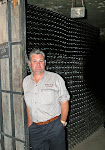Another Italian red wine is being investigated by Italian authorities for possible fraudulent grape mixing. U.S. trade authorities are again stopping the import of some wine until the Italian authorities have concluded their investigations.
The possible fraud is the second case in a year of Italian producers mixing wines with the wrong grapes. Earlier this year Italian authorities questioned whether some Brunello producers in Montalcino were blending their wines rather than using 100 percent Sangiovese grapes, as required.
Now two producers of Vino Nobile Di Montepulciano are being investigated for possibly using grapes from outside the region. Italian standards say the wine must be made from 70 percent Sangiovese grapes and the remaining grapes must come from the same region.
The U.S. Alcohol, Tobacco, Tax and Trade Bureau, have stopped issuing new labels to wine produced from June onwards until the Italian authorities can prove their has been no mixing up of the grape.
"We are waiting to ensure the label claims and for confirmation from Italian authorities," Gail Davis, the bureau's international trade division director, said. Davis said the bureau was also reviewing labeling of French wines from St. Emilion, based on media reports of a dispute over wine classification in France.
Monday 18 August 2008
Tuesday 5 August 2008
Robotic wine taster
A new robotic wine taster has been invented by scientists. Designed for quality control in the field, the device is made up of six sensors which detect substances characteristic of a certain wine variety. Components such as acid, sugar and alcohol can be measured by this detection, and from these parameters it can determine the age and variety of the wine.
The tongue was invented by scientists at the Barcelona Institute of Microelectronics, Spain, and is reported in the Royal Society of Chemistry journal The Analyst.
Wine industry specialists told the researchers they lacked a fast way to assess quality of wines – it takes a long time to send samples to a central laboratory for processing.
Cecilia Jiménez-Jorquera one of the inventors said: "This new tongue is not only swift, but also portable, cheap to manufacture, and can be trained to taste new varieties as required. The device could be used to detect frauds committed regarding the vintage year of the wine, or the grape varieties used."
The tongue was invented by scientists at the Barcelona Institute of Microelectronics, Spain, and is reported in the Royal Society of Chemistry journal The Analyst.
Wine industry specialists told the researchers they lacked a fast way to assess quality of wines – it takes a long time to send samples to a central laboratory for processing.
Cecilia Jiménez-Jorquera one of the inventors said: "This new tongue is not only swift, but also portable, cheap to manufacture, and can be trained to taste new varieties as required. The device could be used to detect frauds committed regarding the vintage year of the wine, or the grape varieties used."
Subscribe to:
Posts (Atom)
